Unpretentious mid-early carrot hybrid Red Cor
Red Core carrots are a popular hybrid that fully meets farmers’ expectations. It is in demand due to its good adaptability to any conditions, high percentage of seed germination and resistance of root crops to cracking.
Description of Red Cor carrots
Germination of seed is 55-70%.
The leaf rosette is spreading. The leaves are long, dissected. The tops are strong, thick, dark green in color. Carrots are characterized by excellent root taste, juiciness, and pleasant aroma.
Red Core designed for spring and winter sowing.
In the photo - Red Cor carrots.
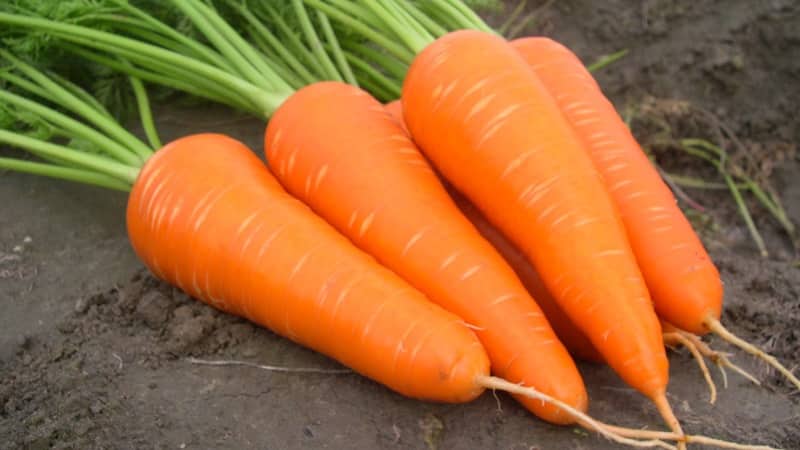
Origin and development
The hybrid was developed by Dutch breeders. Carrot Red Core belongs to the Shantane variety, which is popular among farmers in many countries. There is a theory that the original color of the root vegetables was dark purple. As a result of long-term selection, the taste improved and the carrots acquired a bright orange hue.
Chemical composition, trace elements and vitamins, beneficial properties
Carrot roots are rich in carotenoids, vitamins, carbohydrates. The seeds contain essential and fatty oils.
Vitamins:
- A – 0.2 mg;
- B1 – 0.05 mg;
- B2 – 0.06 mg;
- B5 – 0.32 mg;
- B6 – 0.11 mg;
- B9 – 0.08 mg;
- C – 5.2 mg;
- E – 0.05 mg;
- RR – 1.12 mg;
- H – 0.06 µg;
- K – 13 mcg.
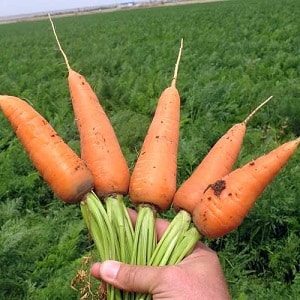 Macronutrients:
Macronutrients:
- calcium – 25 mg;
- magnesium – 37 mg;
- sodium – 21 mg;
- potassium – 185 mg;
- phosphorus – 52 mg;
- chlorine – 50 mg;
- sulfur – 6 mg.
Microelements:
- iron – 0.75 mg;
- zinc – 0.38 mg;
- iodine – 0.05 mg;
- copper – 0.08 mg;
- manganese – 0.22 mg;
- boron – 0.02 mg;
- fluorine – 0.05 mg;
- vanadium – 0.08 mg;
- aluminum – 0.03 mg.
The nutritional value:
- calorie content – 38 kcal;
- proteins – 1.4 g;
- fats – 0.12 g;
- carbohydrates – 7.3 g;
- dietary fiber – 2.5 g;
- water – 86 g;
- starch – 0.2 g;
- organic acids – 5.2 g;
- monosaccharides – 8 g.
100 g of root vegetable contains 10 g fructose and 27 mg beta-carotene.
Carrots are considered a very healthy vegetable. Carotene is converted into vitamin A under the influence of liver enzymes. This vitamin normalizes metabolism, increases immunity to colds, and improves vision. Carrot juice is prescribed for vitamin deficiency, gastrointestinal diseases, anemia, and kidney stones.
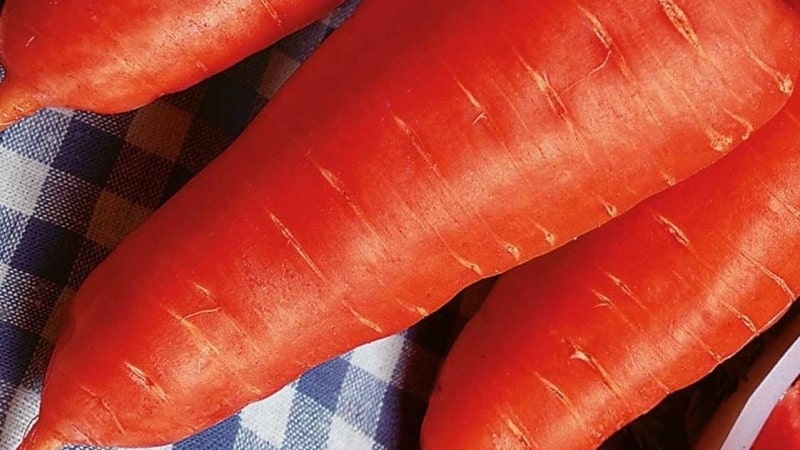
Ripening period
Red Core belongs to the mid-early crops. From the moment the first shoots appear until the start of harvesting, 70-75 days pass.
Other varieties and hybrids of carrots:
Early maturing hybrid with excellent yield: Amsterdam
Productivity
Yields are high. Regardless of the type of soil, from 1 sq. m of land harvest 8-9 kg of carrots. When grown in industrial quantities, 40-45 tons of root crops are collected from 1 hectare of area.
Disease resistance
With timely preparation of the soil before sowing, compliance with the rules of pre-sowing seed treatment and agricultural technology conditions the hybrid exhibits high resistance to many diseases.
Characteristics, description of appearance, taste
Roots have the shape of a cone with a pointed tip. Weight reaches 250-300 g, length - 13-17 cm. Carrots are bright orange in color, the flesh is homogeneous.The core is thin and does not differ in color and consistency from the pulp. The skin is thin, smooth, without branches, the eyes are small.
The taste is excellent. Root vegetables are sweet, juicy, without bitterness, and have a pleasant aroma. Carrots contain increased amounts of sucrose and carotene. The hybrid is not prone to nitrate accumulation.
Regions for cultivation and climate requirements
Red Cor, like all Dutch cultures, has good winter hardiness and is suitable for growing in any climatic conditions. The hybrid is recommended for all regions of Russia, taking into account planting in the northern regions before winter, in the southern regions - in spring and before winter.
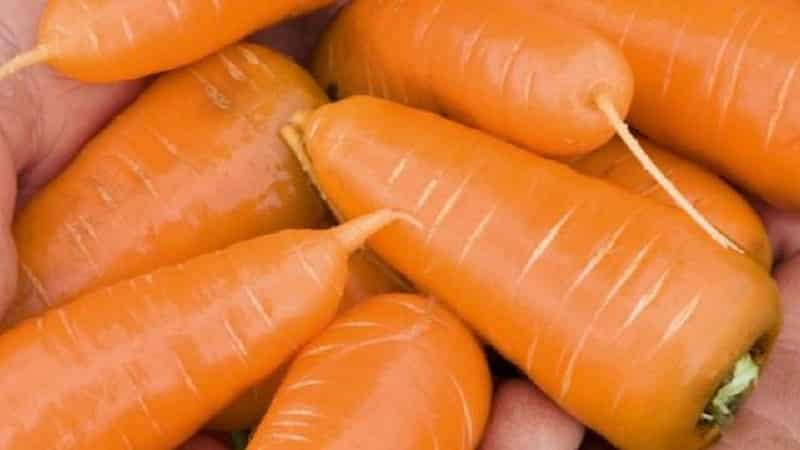
Advantages and disadvantages
Carrot Red Core has a number of advantages:
- Resistant to dry weather and low temperatures.
- High germination rates of seed material.
- Resistance of root crops to cracking.
- High immunity to various cultural diseases.
- Good yield indicators.
- Good tolerance to long-term transportation and storage.
- Contains a high percentage of sugar and carotene.
- Excellent taste and versatility in use.
The disadvantages include:
- With sudden changes in daily temperatures, arrows can form.
- If storage conditions are violated and the humidity in the vegetable storage is unacceptably high, rot will form on the root crops.
Distinctive features
Carrot Red Core compares favorably with other varieties and hybrids:
- nitrates do not accumulate in root vegetables;
- ability to adapt to any climatic conditions;
- increased content of fructose and carotene.
Features of planting and growing
The hybrid is unpretentious to growing conditions. But a number of rules must be followed.It is important to choose a suitable place for planting and take into account what the predecessors were.
Important! It is not recommended to plant carrots in the same area for several years in a row.
The culture does not tolerate excess moisture, therefore, the site should not be located in lowlands, since during rain there is water standing there for a long time.
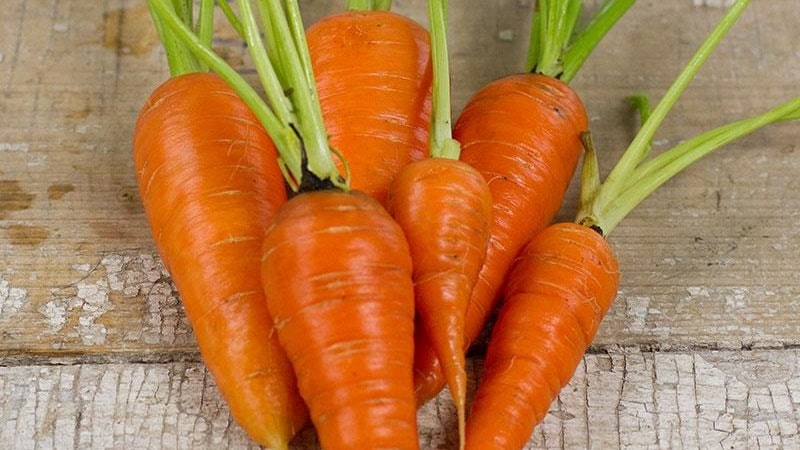
Preparing for landing
Before boarding carry out preparatory treatment of seeds. First, deformed and spoiled seeds are discarded. The remaining seeds are soaked in water for 2 hours. During this time, the good ones will sink to the bottom, and the empty ones will float on the surface of the water. They are also discarded. Afterwards, the seeds for planting are placed in the Fitosporin solution for 1 hour for disinfection.
Red Cor seeds are characterized by a high percentage of germination, but it is recommended to germinate them before sowing.
To germinate, seeds are laid out on a damp cloth., cover and leave in a warm place for 7-8 days. The fabric is periodically moistened. Germinated seeds are ready for planting.
Soil requirements
The hybrid is suitable for growing in all types of soil: sandy, clayey, turf, black soil. If the site has dense, heavy soil, when digging it is mixed with sand, neutral peat, and sawdust. A dense layer of soil leads to deformation of vegetables, they lose their presentation.
In the spring, the soil is dug up, and just before sowing, it is loosened to a depth of 23-25 cm. The top layer of soil is leveled, discarding hard lumps and stones.
Predecessors
Following the rules of agricultural technology, carrots are planted after onions, garlic, potatoes, tomatoes, lettuce.
Attention! It is not recommended to plant carrots after dill, parsley, and celery.
The worst predecessor for carrots is parsley. After its cultivation, a favorable environment for the reproduction of insect pests is formed in the soil.
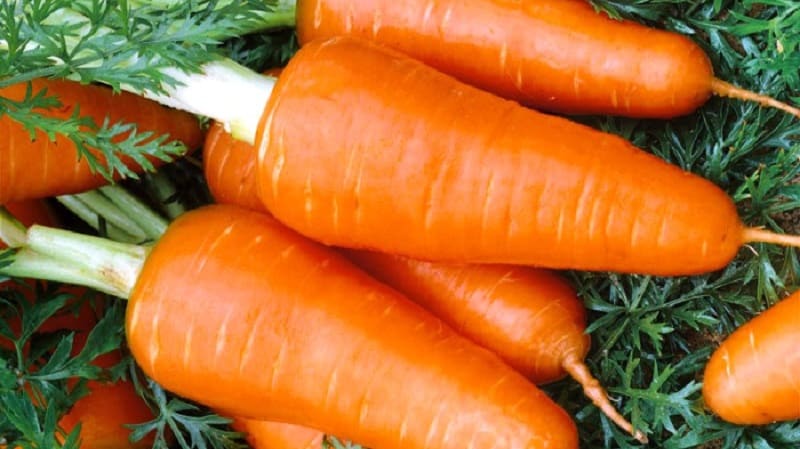
Dates, scheme and rules of planting
The planting time for Red Core carrots depends on the growing region.. In the northern regions, it is recommended to sow before winter to better adapt the crop to the cold climate. In the southern regions, sowing is carried out in mid-spring, when the soil warms up to +13...+15°C.
In a previously dug and leveled area, make grooves 2 cm deep and water them with water. The seeds are placed in grooves at a distance of 2-3 cm from each other. About 20 cm is left between the grooves. The sowing is carefully covered with a layer of soil, without compacting the soil. Along the edges of the groove, it is advisable to create low sides for prevent water from spreading during subsequent waterings.
Features of cultivation
Carrot Red Core prefers well-lit areas. When grown in dark places, the quality and quantity of the harvest decreases.
Reference. A crop planted in the same place for several years in a row loses its resistance to diseases.
When watering It is not recommended to over-moisten the soil. Excess moisture provokes the formation of a soil crust.
Carrot seedlings grow slowly at first, weeds overtake the crop in growth and inhibit it, taking nutrients from the soil. Therefore, before planting, it is important to clear the ground of weeds.
When growing crops, great importance is paid to the looseness and uniformity of the soil. If, during growth, a root crop rests on hard areas of the earth, it bends towards softer layers. With such obstacles, branches form on the root crops.
Loosening is necessary for saturation of the soil with oxygen.If there is not enough air, carrots do not grow sweet enough.
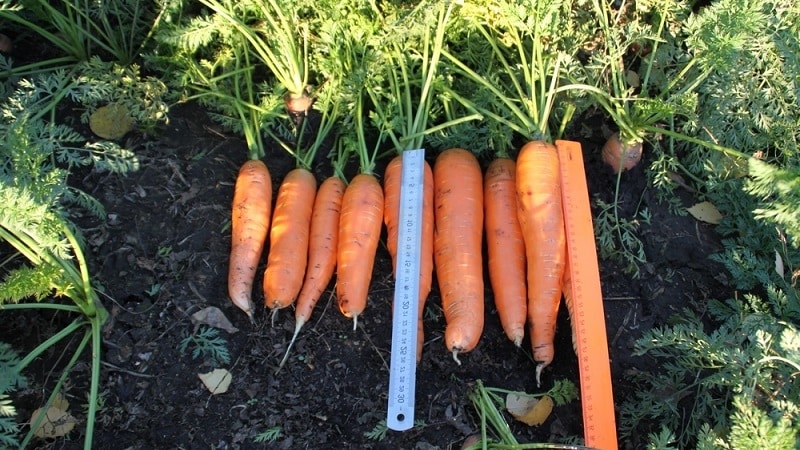
Watering mode
Since the furrows were watered when planting the seeds, there is no need to moisten the soil at first. In hot weather, moderate watering is used, slightly moistening the bed. Watering is carried out every morning until shoots appear. After this, the soil is moistened every other day. Between waterings, loosen the soil to prevent a crust from forming.
Reference. To water carrots, it is better to use the irrigation method, using hoses with spray nozzles, so as not to erode the surface layer of soil.
When the seedlings reach 13-15 cm in height, irrigation is carried out once every 3 days. As the bushes grow, the frequency of watering is reduced to once a week. The frequency of irrigation depends on weather conditions.
With each watering, increase the volume of applied liquid., gradually increasing to 13-15 liters of water per 1 m² of area. A total of 8 waterings per season are recommended.
Important! If you wait a long period of time between waterings and then over-moisten the soil, this will lead to cracking of the root crops.
Watering is stopped 2 weeks before harvest.
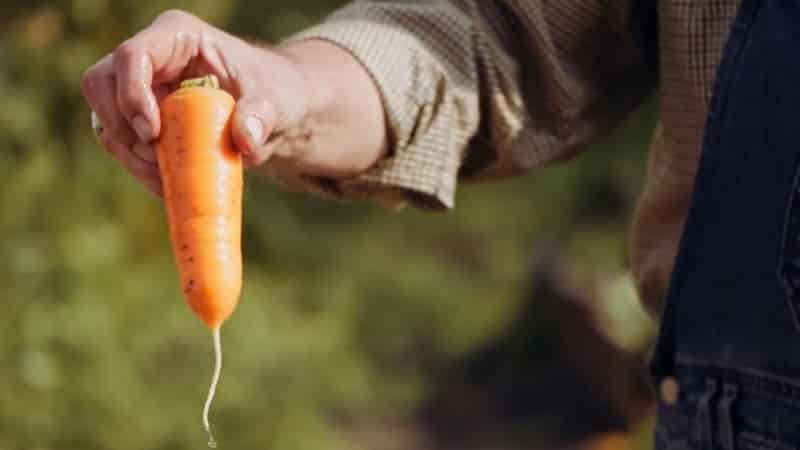
Thinning and weed control
After the seedlings have 4 strong leaves, thinning is carried out. Every growing root vegetable needs some space to grow evenly. Weak copies are removed. The second thinning is carried out when the root crops have already formed. As the bushes grow, the distance between them increases, leaving stronger plants.
During thinning, the beds are weeded and the soil is loosened, while removing weeds. Weeds must be removed regularly, as they inhibit the growth of carrots.
Read also:
Top dressing
Carrot Red Cor responds well to fertilizing without accumulating nitrates. During the season, the crop is fed 4 times every 2 weeks.
The first fertilizing is carried out 3 weeks after emergence a solution consisting of 10 g of urea and 20 g of superphosphate, diluted in 10 liters of water. The second - after 3 weeks, using a solution of “Nitrophoska”, superphosphate and potassium sulfate (15:25:20), diluted in a bucket of water. For the third feeding, add wood ash. During the fourth, nitrogen fertilizers are not used, but a solution of boric acid (2 g per 10 liters of water) is introduced.
Attention! It is not recommended to add fresh organic matter to the crop. This will lead to rotting of root crops in the soil or during storage.
Disease and pest control
With incorrect agricultural practices, phomosis appears on the crop (dry rot). The disease is characterized by brown spots on root crops. This creates an area of dark emptiness. To combat Phoma, treat the soil with the drug "Maxim", diluted 1:1 with water.
White rot forms a fungal light coating, as a result of which the root vegetables become watery.
Black rot (alternaria blight) manifests itself in darkening and curling of the tops. Yellowish spots gradually appear, leading to drying out of the leaves. Dry rot appears on root crops.
The drugs “Rovral” and “Maxim” help in the fight against rot.
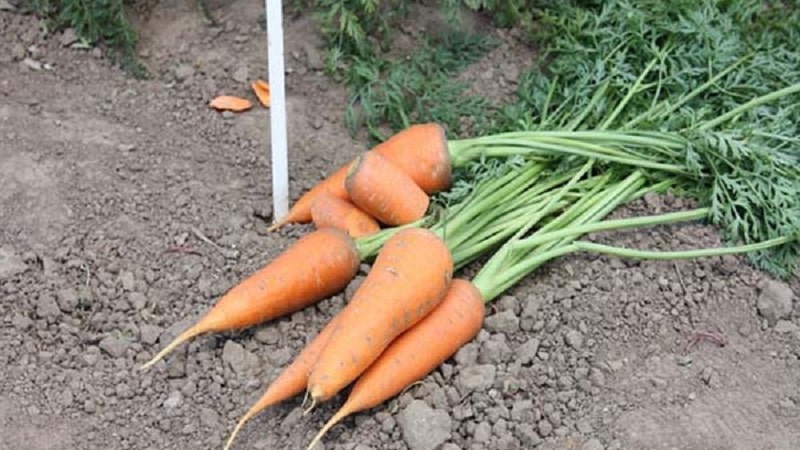
For brown spot tops and root crops become covered with dark or rusty spots, and the seedlings die. Treatment is carried out by spraying with Gamair fungicide diluted in water (2 tablets per 1 liter).
When powdery mildew appears use “Fitosporin” by spraying the plants with a solution consisting of 5 g of the drug and 10 liters of water.
Root vegetables Carrot fly can cause harm. The fight against it is carried out by spraying with a “Karate” solution (0.2 ml per 1 liter of water).
Dangerous for mole cricket culture, feeding on root vegetables. To destroy it, the drug “Bazudin” is added to the kidney in powder form at the rate of 1.5 g per 1 m² of land.
The slug causes damage to the tops. The drug “Thunderstorm” has proven itself well against it. It is scattered around the beds in the amount of 3 g per 1 m².
Difficulties in growing
In poorly loosened soil Root crops are formed of irregular shape.
If weeds are not removed in time, the carrots will grow weak.
Watering needs to be adjustedto avoid cracking of root vegetables.
Harvest and storage
Harvesting begins at the end of summer. To do this, choose dry weather. Stop watering 2-3 weeks before the start of harvesting.. You should not delay the collection time, as the pulp will become loose and the taste will deteriorate. After harvesting, the vegetables are dried and stored until spring.
How and when to collect
Carrot begin to collect when the lower leaves on the tops turn yellow. Vegetables are pulled out of the ground by their tops. Then dry for a week in a dry room, unfolded. Before storage, the tops are cut with a sharp knife. Vegetables are checked for damage. After this, the carrots are placed in a vegetable store.
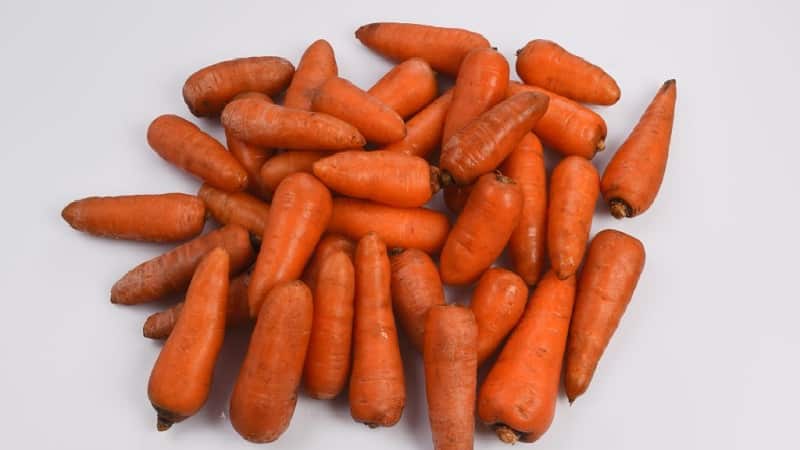
Storage features and shelf life
Selected vegetables without stains, rot or mechanical damage Store in a clean, dry place with good ventilation. Storage temperature is maintained within 0…+4°C, humidity – 85-90%. If the conditions are met, the harvest can be stored until spring without losing its taste or appearance.
Keeping quality indicators reach 95%.
Advice from experienced gardeners
Experienced gardeners recommend Dry the carrots well before storing them. Rot will begin to form in places where moisture remains.
To prevent vegetables from spoiling, you must first thoroughly disinfect the storage.
Experienced gardeners It is recommended to prevent the formation of soil crust. Without air access, carrots lose their sweetness.
Reviews of Red Cor carrots
Reviews about the Red Core variety are mostly positive. Farmers note excellent taste and commercial qualities, stable yields and ease of cultivation.
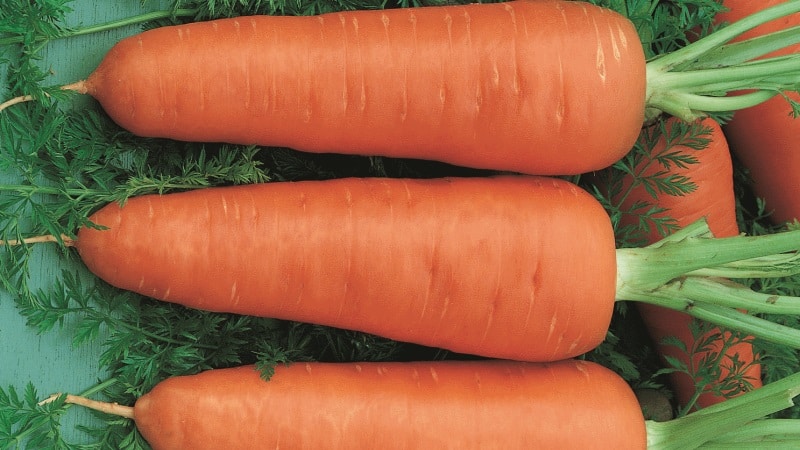
Natalya, Orel: “I bought Red Core carrot seeds after reading the description of the variety on the package. She grew up without any problems. Root vegetables are smooth, crispy, taste sweet".
Vladimir, Novosibirsk: “I tried to plant Red Core carrots in November. In the spring, friendly shoots sprang up. I had to break through several times. I liked the taste".
Anatoly, Tula: “A neighbor on the property shared some Red Cor carrot seeds. Sowed at the end of spring. I thinned it several times over the summer. The root crops turned out smooth, without branches or cracks.”.
Conclusion
Red Cor carrot hybrid can grow on any type of soil and under different climatic conditions. Withstands long-term storage up to 6 months. Root vegetables are distinguished by their sweetness and juiciness. For such positive characteristics, many gardeners and large farmers prefer to grow this particular crop.